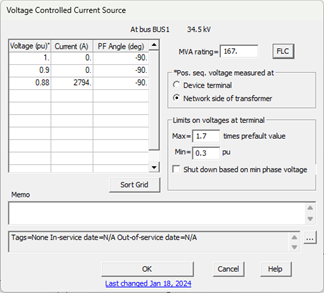
Figure J2-1 shows the dialog box of a VCCS that models an example STATCOM for fault response. This STATCOM has a maximum output current of 2794 amps, no short-term overload capabilities, and will output current for faults when its regulated bus voltage drops below 0.90 per unit. The device will not output current if its terminal voltage (not the network side of its transformer) is below 0.3 per unit, or if its terminal voltage is above 0.9 per unit. It is noteworthy that the regulating voltage is measured at the “network side of the transformer” since that is the bus voltage the STATCOM controls. Should the actual STATCOM regulate its own terminal voltage, the “Device terminal” option should be selected instead.

Figure J2-1 – VCCS STATCOM representation for fault studies in OneLiner
The table shown in Figure J2-1 differs from the table shown in the user manual of OneLiner Version 15.7. The updated recommendation shown in Figure J2-1 is based on experience accumulated in modeling STATCOM devices using the VCCS model since the release of OneLiner Version 15.7. Further explanation is below.
Even though the actual STATCOM being modeled in Figure J2-1 may have response characteristics for voltages above 0.88 per unit, these characteristics are not included in the VCCS voltage-current table. Our observation in most cases has been that modeling STATCOM response characteristics within the normal voltage operating range results in the VCCS outputting significant prefault current. That is because most OneLiner network models do not include generation dispatch, load models, and a power flow solution. Instead, the prefault voltages for fault calculations are typically estimated using the “From a linear network solution” option in OneLiner. Significant prefault currents interfere with the initial conditions of other nonlinear models in the network and can produce unexpected results. This is a limitation of using a VCCS to represent a STATCOM for fault studies in OneLiner.
The example table provided in the user manual of OneLiner Version 15.7 is shown in Figure J2-2. From the voltage-current table in this figure, it can be seen that a prefault voltage above 1.0355 or below 1.0345 will result in maximum current flowing from the VCCS even without a fault. Since the voltage is not based on a valid power flow solution, the current flowing from the VCCS is not usually reflective of the expected operation of the actual device in prefault conditions (with some exceptions). Therefore, the current flowing from the VCCS model would usually be incorrect and it may influence network voltages in the neighborhood of the VCCS model and introduce error into the fault solution.